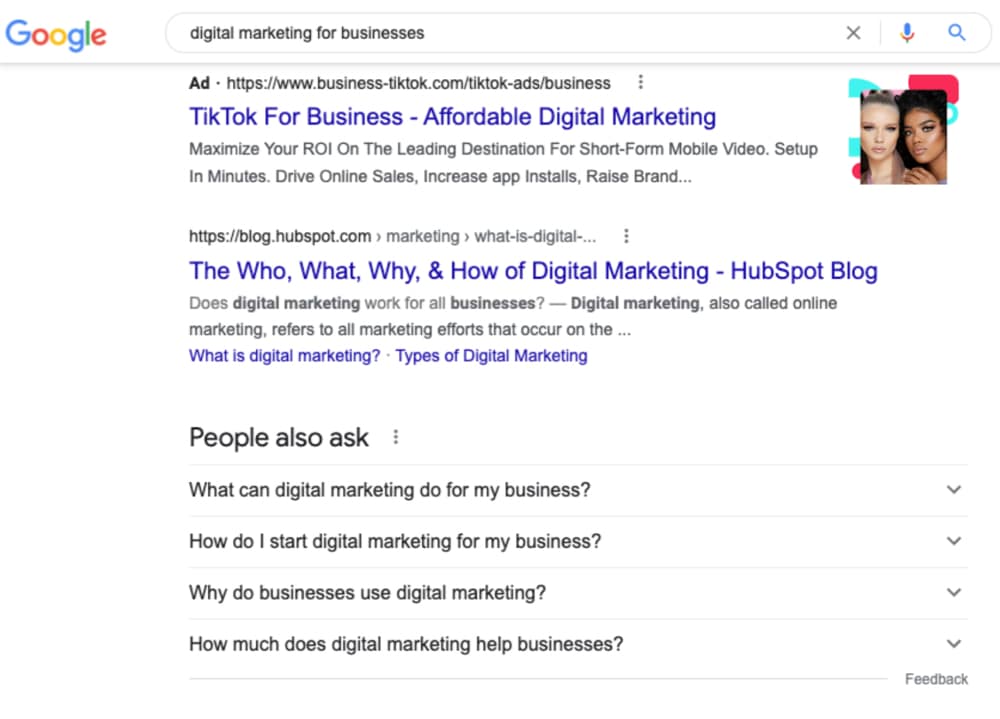
Targeting specific keywords has long been a central practice in search engine optimization. In fact, you could argue that keyword targeting was the original SEO method. You picked out keywords that had value to your business and included as many of them as possible on each page. We’ve come a long way since those early days, of course, but the concept of keyword targeting remains just as relevant today as it has ever been.
With that said, understanding the evolution of Google and how keywords are used in the search ranking process is essential to find yourself on page one of SERPs. These days, one of the big topics that is shaping the SEO landscape is user intent. Here we’ll dive into a discussion on what user intent is, why it is becoming more and more important in inbound marketing, and how you can use it to your advantage.
What is User Intent?
As the term “user intent” is at the heart of what we will be covering in this article, it’s important to get a clear definition out of the way right from the start.
When an internet user visits Google or any other search engine to perform a search, that person is looking for something specific. Given the size and scope of the internet, it could be just about anything. The searcher will need to pick a word or a phrase to submit to the search engine, but it is what lies behind those words that we are most interested in here—the intent behind the search.
Simply put, user intent is what the searcher is trying to find. Sometimes, it’s obvious. For example, searches about what time a store opens or when a particular team plays its next game need no further interpretation. The intent of those searches is self-evident, and Google is sure to return a satisfying answer straight away.
In other cases, it’s harder to determine what the searcher wants based on the words that were chosen for the search. For example, someone looking for information on car maintenance might want information on where they can take their vehicle for an oil change, or they might want step-by-step instructions on how to do it themselves. Parsing through the wording they used to figure out what type of results are desired is tricky business, and something that search engines like Google are constantly improving.
If you are interested in the technical, behind-the-scenes side of how this works, Google’s BERT algorithm update in 2019, and the update to MUM, help to explain how the search engine is getting better and better at knowing what people want. With MUM, which stands for the Multitask United Model, Google has managed to create something that is 1,000 times more powerful than its predecessor at processing natural language.
While those details can be interesting, they are of limited value to you as a marketer. Rather than getting bogged down in how the search engines determine search intent, there is a more pertinent question to ponder… How can you create content that perfectly matches the intent of the user? After all, if Google is working this hard to master search intent, you should be aiming to create the kind of content that will do the same. That way, when Google and other engines go looking for the kinds of content on the web that line up precisely with user intent, your pages will have a chance to rise to the top.
From Keywords to User Intent
As it becomes clearer that user intent is going to play a massive role in search engine optimization moving forward, it’s obvious that lazy SEO tactics are going to become virtually useless. Long gone are the days when you could pad a blog post full of keywords—any keywords—and have a chance to rank. Today, those keywords need to be topically relevant and the content you produce needs to line up with what it is that the user hopes to find.
Hard work will be required to match user intent with all of your content. For each keyword you discover during the research process, you’ll have to think carefully about the actual intent behind that search. What was the user looking for when performing the search? What kind of content would best provide the solution for their search? This can be a time-consuming process, but those who are willing to go the extra mile will have an advantage in the rankings when all is said and done.
It’s also worth noting that this shift toward user intent is going to only further emphasize the value of being an expert, or at least someone with knowledge, in a given niche. It’s hard to match user intent, or even to understand user intent, if you aren’t familiar with the market in question. In a way, this is actually good news. If you are invested in a market and have spent years growing your knowledge and developing authentic experience, you may have an inherent advantage in the rankings over those who are just trying to make a quick buck. Leverage your understanding of the market to properly interpret search intent and create content that is ideally aligned with what the searchers want to find.
The Value of Long-Tail Keywords
Those who have spent any time at all working in SEO are familiar with the term “long-tail keyword”. If that term is new to you, it simply refers to the countless keyword searches that occupy the “long-tail” of a search graph. Here’s a quick explanation of long-tail keywords, using our car maintenance example from earlier:
- A search for “car maintenance” would be a short-tail keyword, since it likely gets a lot of volume and is very broad in definition and interpretation
- A search for “Toyota car maintenance” would be a move toward the longer-tail, since it gets more specific. However, this is still a relatively broad term that would get a high search volume
- A search that fully qualifies as a long-tail keyword would be something like “car maintenance for a 1997 Toyota Corolla”. That’s a very narrow, specific search. It likely doesn’t receive significant search volume in a given month, but those who perform that search know exactly what they are looking for.
There are a couple of things to like about long-tail keywords. First, the user intent tends to be self-explanatory. With more information to work with within the search query, you don’t have to guess what the searcher wants to find; they told you everything you need to know. That’s a good start, as you should be able to put together suitable content for every long-tail keyword you uncover, just by thinking quickly about the intent behind that specific search.
The other big selling point for long-tail keywords, and the reason they are so sought-after in SEO circles, is competition. That is, the lack of competition that exists for many of these search terms. Let’s use our car example yet again to highlight how this works. A search for “car maintenance” on Google is big and broad, so the results would be cluttered by some of the biggest automotive brands in the business. Unless you are doing marketing for a large, established site, you’d have very little chance to rank for this search.
Moving out into the long-tail section, however, would open up many possibilities. With the example search of “car maintenance for a 1997 Toyota Corolla”, the competition will be significantly reduced. Since that doesn’t get searched very often, the big players in the space haven’t taken the time or effort to create content on that precise topic. A targeted piece of content that features that long-tail keyword would have a great chance to rank, simply due to reduced competition. This same concept applies across the board for any topic and in any niche.
Leveraging the “People Also Ask” Section

Long-tail keywords are great, but they aren’t always easy to find. This is simply because there are so many different ways to ask the same question. According to Google, somewhere around 15% of searches are original, meaning you wouldn’t have found that search during research, because it had never previously been performed by a Google user.
One great way to get around this issue to find useful keywords is to consult the “People Also Ask” or the “Related Searches” sections in the Google search results. Here, you’ll find ideas that could provide you with new long-tail keywords that can be targeted with future content. Remember our “Toyota car maintenance” search from above? Here is what is returned in the “Related Searches” section for that query:
- Toyota car maintenance checklist
- Toyota maintenance cost
- Toyota Camry maintenance schedule
- Toyota service schedule
Just that quickly, you have several ideas that may serve as the foundation for another round of content. To get ideas in the “People Also Ask” format, we need to turn a search into a question. So, we entered “what maintenance is required for a Toyota Corolla 97?”. Some excellent long-tail options were produced:
- What maintenance does a Toyota Corolla need?
- Is a 1997 Toyota Corolla reliable?
- How often should a Toyota Corolla be serviced?
- Is Toyota Corolla high maintenance?
You could continually ask different questions in the search bar and come up with a virtually bottomless pit of ideas to mine. Also, within the “People Also Ask” section, there is an answer automatically pulled from the search results and placed in the drop-down for that question. So, if you target content that answers the question nicely, you may win that spot and gain exposure (and hopefully traffic) for your site.
One Thing About SEO That Never Changes
Accurately interpreting user intent is surely a big part of modern SEO, and using long-tail keywords is a great way to both understand intent and find low-competition opportunities. With all that said, there is one thing about SEO that never changes… You need to serve your real, human site visitors with a quality experience.
With so much attention paid to what Google wants to see and how to move up the rankings, it’s easy to get lost and forget your true purpose. Most likely, you have an audience of actual human beings in mind that you want to turn into loyal customers for your business. Don’t let your obsession with search rankings lead you to do things that degrade the site experience and cause your audience to turn to the competition instead.
For every SEO action you take, be sure to pause and consider how it will impact your target market. In some cases, like when creating quality content that answers specific questions, you’ll be doing right by both the search engines and the human visitors. That’s not always the case, however, so pay attention to this critical point and be sure the site you present to the world is something that presents your business in the best possible light.
Most Popular Articles

Seeing Favicons in Your Google Search Results? Here’s Why…
Have you noticed anything different in your Google Search results lately? Google added tiny favicon icons to its organic search results in January. It was…

Business Growth and Digital Marketing News & Tips 4-14-24
Did you know? It’s five to twenty-five times more expensive to acquire a new customer than to retain an existing one. Increasing customer retention by…

Business Growth and Digital Marketing News & Tips 3-28-24
With the desire for precise measurement tools to determine ROI, there has been a rise in attention metrics. These metrics, which often utilize eye-tracking data,…








